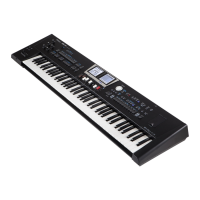Editing one or several tracks (Track Edit)
89
Parameter Setting Explanation
From Bar
For details information see p. 85.
From Beat
From Cpt
To Bar
To Beat
To Cpt
Bias –99~99
The BIAS parameter allows you to
specify by how much the velocity
values should change. Select a positive
value to increase the velocity (the
value is added to the velocity value
of the aected notes) or a negative
value to decrease the velocity values
(that value is subtracted). Select “0” if
you prefer to work with the MAGNIFY
parameter (see below).
Magnify 0~200%
This parameter works like a
“Compander” eect (a dynamics
processor that simultaneously acts as
compressor and expander), although
it processes MIDI data: by selecting a
value above “100%” you increase the
dierences between high and low
velocity values in the selected range.
Values below “64” are lowered, while
values above “64” are increased. The
result is therefore that the dierence
between pianissimo and fortissimo
becomes far more pronounced.
“Magnify” values below “100%” have
the opposite eect: they push all
velocity towards the imaginary center
of “64”, thus reducing dierences in
playing dynamics.
From Note C-~G9
This parameter allows you to set the
note (or lower limit of the note range)
to be modied within the specied
“From”/“To” time range.
To Note C-~G9
This parameter allows you to set
the upper limit of the note range
to be modied within the specied
“From”/“To” time range.
CHANGE GATE TIME
This function allows you to modify the duration of the notes in
the selected time (From/To) and note (From/To Note) ranges.
We recommend you only use this function to shorten notes that
suddenly seem too long when you assign a dierent sound to the
track in question. You cannot view the duration of the notes here,
which makes editing the data “enbloc” a little bit hazardous. Use
the MICRO EDIT environment to change the duration of individual
notes.
Left Display
Right Display
After selecting a sound with a slow release (i.e. a sound that lingers
on after all notes have been released), however, CHANGE GATE TIME
will help you cut the notes down to size and thus avoid undesirable
overlaps.
Parameter Setting Explanation
Track All, Trk 1~ Trk 16
Allows you to select the track you wish
to edit. You can also select “ALL” here,
in which case the operation applies to
all tracks.
From Bar
For details information see p. 85.
From Beat
From Cpt
To Bar
To Beat
To Cpt
Bias (Cpt) –4800~4800
This parameter sets the amount by
which the duration (or gate time) of
the selected notes is to change. The
shortest possible GATE TIME value is
“1” (used for all drum notes), so that
selecting “–1000” for notes with a GATE
TIME value of “1” in the specied time
range still leaves you with the same
value.
Magnify 0~200%
Use this parameter rather than BIAS to
produce proportional changes to the
aected GATE TIME values.
Values below “100%” decrease the
duration, while anything above “100%”
increases it. Select “100%” if you prefer
to work with the BIAS (CPT) parameter
(see above).
From Note C-~G9
This parameter allows you to set the
note (or lower limit of the note range)
to be modied within the specied
“From”/“To” time range.
To Note C-~G9
This parameter allows you to set
the upper limit of the note range
to be modied within the specied
“From”/“To” time range.
MERGE
Use this parameter to combine the data of two tracks (i.e. of all data
the two tracks contain – from start to nish). The combined version
can be found on the destination track (Dest Trk). Be aware that all
data will use the same MIDI channel. The “Source Trk” track could
therefore be used for recording a new part.
Left Display
Right Display
Parameter Setting Explanation
Source Track Trk 1~ Trk 16
Allows you to select the track whose
data should be added to those of the
“Dest Trk” track.
Dest Trk
Trk 1~ Trk 16
(except the track
selected as
“Source Trk”)
Use this parameter to specify the track
that should contain a combination of its
original data and those of the selected
source track.

